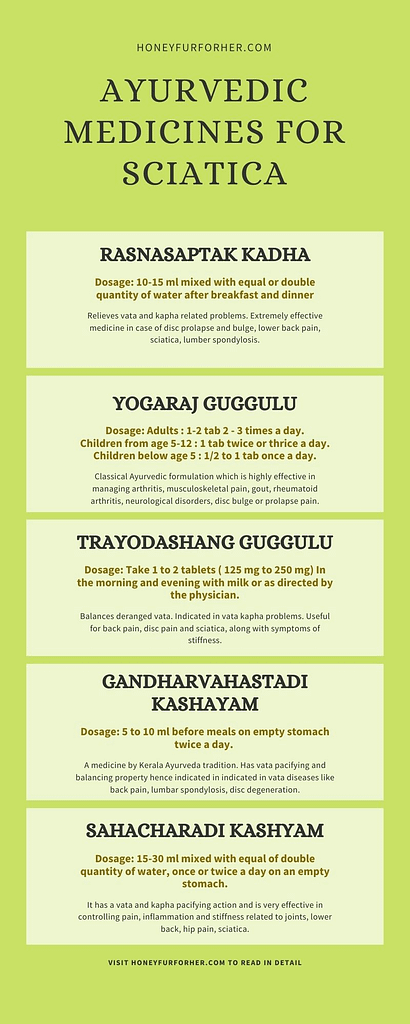Sciatica is a very common health issue and is generally being seen today as a lifestyle disease. It is described as the compression of the longest nerve in the body called the Sciatic nerve. It runs down from the lower back (lower spinal area) through the back of the leg reaching down to the toes. This is why when the nerve is compressed, a constant tightness, numbness, pain or tingling is felt along the same pathway which is also sometimes referred to as lumbar radiculopathy.
Allopathy gives many reasons for this problem most common of which being
- Disc Bulge
- Herniated Disc
- Stenosis
- Spondylosis
- Sacro-iliitis
- Muscular Spasm
- Pregnancy
- Disc Degeneration
- Piriformis Syndrome
- Trauma or Accident
Ayurveda on the other has a different perspective on Sciatica. In Ayurveda, it is considered a disease of vata vitiation. Sometimes kapha is also involved making it a vata-kaphaj vyadhi. It is known as Gridhrasi (Gridh means vulture denoting the way the patient walks while suffering from it).
Lumbar spondylosis is the osteoarthritis of the lumbar spine, which shows symptoms of stiffness and low back pain in movement. It is considered a Dhatukshayaja vata vyadhi where the vata is residing in the asthi dhatu (vertrebral column is considered asthi dhatu).
Both Sciatica and Lumbar spondylosis are considered as a fully treatable condition in Ayurveda. Various vatashamak panchakarma therapies are used for the treatment, the most effective being Patra Pinda Sweda (elai kizhi), Kati Vasti, Vaitarna vasti, Matrabasti, Sira vedana (Venesection), Agni karma (heat therapy).
The common oral herbs and medicines which are used for the treatment of sciatica and lumbar spondylosis are rasnasaptak kadha, Yograj guggulu, Trayodasanga guggulu, gandharvahasthaadi kashaayam, sahacharadi kashyam. Lets learn about them in detail
1. Rasnasaptak Kadha / Kashyam / Kwath
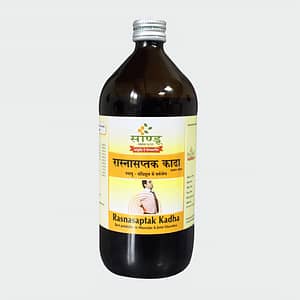
This is a classical Ayurvedic formulation which is a combination of 7 powerful pain relieving and anti inflammatory herbs i.e. Rasna (Pluchea Lanceolata), Guduchi (Tinospora cordifolia) , Aragwada (Cassia Fistula), Devdaru (Cedrus deodara), Gokshura (Tribulus Terrestris), Erandamula (Ricinus communis), Punarnava (Boerhaavia diffusa).
The classical reference of this medicine is found in Chakradatta and it is a Vatakaphahara (relieves vata and kapha related problems).
It is an extremely effective medicine in case of disc prolapse and bulge, lower back pain, sciatica, lumbar spondylosis, cervical spondylosis, thigh pain, flanks, hip, pelvis and hip joint pain, Lumbo-Sacral pain, Coccygeal pain, rheumatoid arthritis.
How to consume?
Although it is a medicine which requires a doctors prescription, the general dosage is about 10-15 ml mixed with equal or double quantity of water after breakfast and dinner. It is also sometimes prescribed with a pinch of dry ginger powder (sunthi) to be added in the kashyam. This is prescribed by the doctor depending on the prakriti of a person.
2. Yogaraj Guggulu
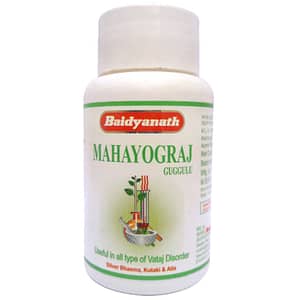
Yogaraj guggulu is a famous classical Ayurvedic formulation which is highly effective in managing arthritis, musculoskeletal pain, gout, rheumatoid arthritis, neurological disorders, disc bulge or prolapse pain, knee pain, coccyx pain, back pain, ligament pain, shoulder dislocation, siatica, cervical and spondylosis, joint and bone related disorders.
It is considered to be a great help for vata related disorders although it is tridosha balancing in nature. It contains 27 herbs mixed with liquified guggulu and ghee as a base.
How to consume?
General adult dosage is about 1-2 tablets, 2 – 3 times a day before or after meals.
For children below 5 years: 1/2 to 1 tab once or twice a day.
For children of 5 – 12 years: 1 tab twice or thrice a day.
For children of 12+ years: Same as adult dosage.
3. Trayodashang Guggulu
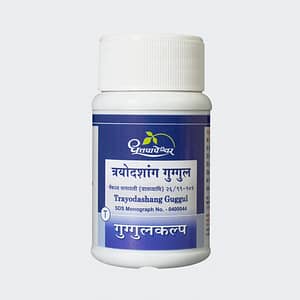
Trayodashang Guggulu
Trayodashang Guggul is another formulation which is made from 14 ingredients with 12 being herbs mixed with liquified guggulu and ghee at the end of its preparation process.
This formulation is also helpful in vata related diseases, specially back pain, bone, joints and bone marrow (asthi and majja dhatu) related diseases.
In case of back pain, disc pain and sciatica, it is prescribed when the patient shows symptoms of pain as well as stiffness (which is considered a sign of degeneration and vata kapha vyadhi) while yograj guggulu is prescribed when there is only pain.
Apart from back pain, it is also indicated in low back stiffness, cervical and lumbar spondylosis, bone fractures, jaw or muscle stiffness, uterine disorders.
Yogaraj guggulu is used for curing vata dominant disorders while trayodashang guggulu is for vata and kapha disorders.
How to consume?
Take 1 to 2 tablets ( 125 mg to 250 mg) In the morning and evening with milk or as directed by the physician.
4. Gandharvahastadi Kashayam
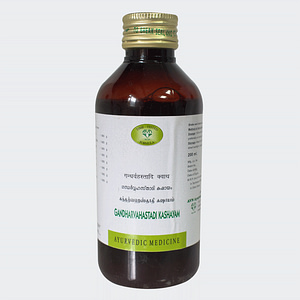
Gandharvahastadi Kashayam is an Ayurvedic medicine which is based on the Kerala Ayurveda tradition and is manufactured mainly by south indian pharmacies like Kottakal, AVN Ayurveda, Arya Vaiya Sala etc. It is a decoction made out of 8 herbs out of which Gandharvahasta (castor seeds) is the main base on which it is named.
It is a vata pacifying and balancing medicine which is mainly given but cleaning the digestive system and channelizing the vata in right direction. It has virechana (purgative) properties which helps in clearing out the vata imbalance and strengthening the digestive system. Due to this property, it is indicated in vata diseases like back pain, lumbar spondylosis, disc degeneration, ascites, heal and foot pain, anorexia, bloating.
How to consume?
5 to 10 ml before meals on empty stomach twice a day.
5. Sahacharadi Kashyam / Kwatham
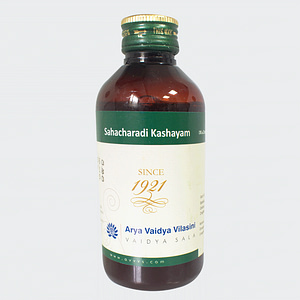
Sahacharadi kashyam is a powerful combination of Sahachara (Strobilanthus Ciliatus), Devdaru (Cedrus Deodara) and Shunti (Dry ginger). It has a vata and kapha pacifying action and is quite effective in controlling pain, inflammation and stiffness related to joints, lower back, hip pain.
It is useful in sciatica, vericose veins, lumbar spondylosis, palsy, disc prolapse, paralysis or any type of lower back pain. The classical reference of this medicine is found in Sahasra Yogam.
How to consume?
It can be taken from 15-30 ml mixed with equal of double quantity of water, once or twice a day on an empty stomach.
It is also available in form of tablets by some pharmacies. 1-2 tablets twice a day can be taken.
Other Medicines & Thailam (Oils) Worth Mentioning
Used For Massage: Sahacharadi Thailam, Ksheerabala Thailam
Used For Massage & Kati Vasti treatment: Mahanarayan Thailam
For Oral Administration (only on doctor’s advice) : Ksheerabala Thailam
Used For Matra Basti in lumbar spondylosis : Rasna taila
Did you find this post useful? Would you like to get back to it later? Save THIS PIN below to your Pinterest Natural Living or Ayurveda board!
